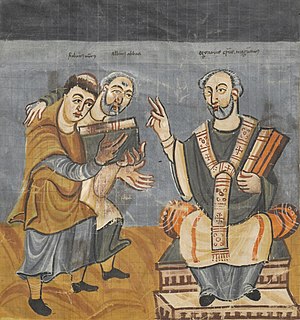
Alcuin of York – also called Ealhwine, Alhwin, or Alchoin – was a Northumbrian scholar, clergyman, poet, and teacher from York, Northumbria. He was born around 735 and became the student of Archbishop Ecgbert at York. At the invitation of Charlemagne, he became a leading scholar and teacher at the Carolingian court, where he remained a figure in the 780s and 790s. "The most learned man anywhere to be found", according to Einhard's Life of Charlemagne, he is considered among the most important intellectual architects of the Carolingian Renaissance. Among his pupils were many of the dominant intellectuals of the Carolingian era.
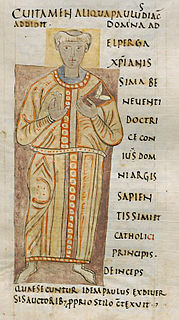
Paul the Deacon, also known as Paulus Diaconus, Warnefridus, Barnefridus, or Winfridus, and sometimes suffixed Cassinensis, was a Benedictine monk, scribe, and historian of the Lombards.

Verona is a city on the Adige River in Veneto, Italy, with 258,031 inhabitants. It is one of the seven provincial capitals of the region. It is the largest city municipality in the region and the second largest in northeastern Italy. The metropolitan area of Verona covers an area of 1,426 km2 (550.58 sq mi) and has a population of 714,310 inhabitants. It is one of the main tourist destinations in northern Italy because of its artistic heritage and several annual fairs and shows as well as the opera season in the Arena, an ancient Roman amphitheater.

Pepin or Pippin, born Carloman, was the son of Charlemagne and King of the Lombards (781–810) under the authority of his father.
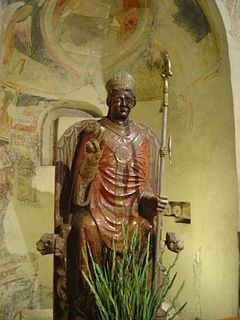
Zeno of Verona was either an early Christian Bishop of Verona or a martyr. He is a saint in the Roman Catholic Church and in the Orthodox Church.
The Carmen de Hastingae Proelio is a 20th-century name for the Carmen Widonis, the earliest history of the Norman invasion of England from September to December 1066, in Latin. It is attributed to Bishop Guy of Amiens, a noble of Ponthieu and monastically-trained bishop and administrator close to the French court, who eventually served as a chaplain for Matilda of Flanders, William the Conqueror's queen. Guy was an uncle to Count Guy of Ponthieu, who figures rather prominently in the Bayeux Tapestry as the vassal of Duke William of Normandy who captured Harold Godwinson, later to become King Harold II of England, in 1064.

Saint Paulinus II was a priest, theologian, poet, and one of the most eminent scholars of the Carolingian Renaissance. From 787 to his death, he was the Patriarch of Aquileia. He participated in a number of synods which opposed Spanish Adoptionism and promoted both reforms and the adoption of the Filioque into the Nicene Creed. In addition, Paulinus arranged for the peaceful Christianisation of the Avars and the alpine Slavs in the territory of the Aquileian patriarchate. For this, he is also known as the apostle of the Slovenes.
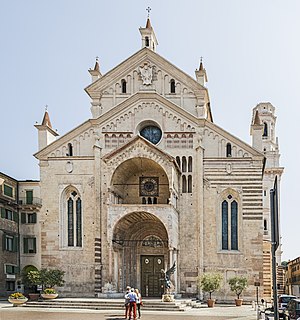
The Diocese of Verona is a Roman Catholic ecclesiastical territory in northern Italy. The diocese belongs to the Ecclesiastical Province of Venice. The bishop of Verona has his seat in Verona, Veneto. The episcopal throne is in the cathedral, which had originally been dedicated to S. Maria Matricolare and S. George.

The March of Verona and Aquileia was a vast march of the Holy Roman Empire in northeastern Italy during the Middle Ages, centered on the cities of Verona and Aquileia. Seized by King Otto I of Germany in 952, it was held by the Dukes of Bavaria; from 976 in personal union with the Duchy of Carinthia. The margravial regime ended with the advent of the Lombard League in 1167.
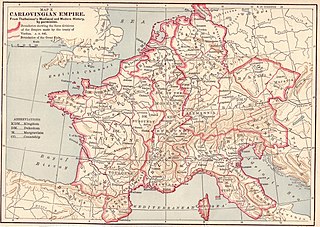
The March of Friuli was a Carolingian frontier march, established in 776 as the continuation of the Lombard Duchy of Friuli, established against the Slavs and Avars. It was ceded to the Duchy of Bavaria as the March of Verona in 952. Its territory comprised parts of modern-day Italy, Slovenia and Croatia.
The anonymous Saxon poet known as Poeta Saxo, who composed the medieval Latin Annales de gestis Caroli magni imperatoris libri quinque was probably a monk of Sankt Gallen or possibly Corvey. His Annales is one of the earliest poetic treatments of annalistic material and one of the earliest historical works to concentrate on Saxony. It is considered characteristic of the dénouement of the Carolingian Renaissance.
Hibernicus exul was an anonymous Irish Latin poet, grammarian, and dialectician. His works include a comic mock epic, a panegyric to Charlemagne, epigrams of advice to young scholars and a poetic overview of the seven liberal arts.
Laudes Mediolanensis civitatis, also known as the Versum de Mediolano civitate or Versus in laudem mediolanensis civitatis, is an early medieval Latin poem, which describes and praises the Italian city of Milan. It dates from the mid-8th century, during the era of the Lombard Kingdom. The poet is unknown. The poem is an encomium, an example of the urban eulogy genre. It celebrates not only the Christian heritage of Milan, but also its pagan Roman history. It is considered to be the earliest surviving medieval description of a city. The poem served as a model for the Carolingian Versus de Verona, a similar encomium to its rival Verona, written around 50 years later.
Rythmusde Pippini regis Victoria Avarica, also known by its incipit as Omnes gentes qui fecisti, is a medieval Latin encomium celebrating the victory of King Pepin of Italy over the Avars in the summer of 796. It is associated with an experimental trend of the Carolingian Renaissance and, though its author, probably a cleric, is unknown, is associated with the Veronese "school" of poets, one of whom, at the same time, produced the Versus de Verona, praising the royal capital of Italy, where it and De Pippini were probably written.
The Planctus (de obitu) Karoli, also known by its incipit A solis ortu, is an anonymous medieval Latin planctus eulogising Charlemagne, written in accented verse by a monk of Bobbio shortly after his subject's death in 814. It is generally considered the earliest surviving planctus, though its melody is written in tenth-century neumes, one of the earliest surviving examples of this sort of musical notation. The poem has been translated into English by Peter Godman.
Moduin, Modoin, or Mautwin was a Frankish churchman and Latin poet of the Carolingian Renaissance. He was a close friend of Theodulf of Orléans, a contemporary and courtier of the emperors Charlemagne and Louis the Pious, and a member of the Palatine Academy. In signing his own poems he used the pen name Naso in reference to the cognomen of Ovid. From 815 until his death he was the Bishop of Autun.
Angelbert was a Frankish soldier and poet, possibly from Aquitaine. His "Verses on the Battle that was Fought at Fontenoy" are a first-hand description of the Battle of Fontenoy of 25 June 841, in which he participated with the army of Lothair I. They are an important piece of battle literature from the twilight of the Carolingian Renaissance. Historian Bernard Bachrach has examined them as a source for the emotional effects of battle during the ninth century.
Dubthach maccu Lugair, is a legendary Irish poet and lawyer who supposedly lived at the time of St Patrick's mission in Ireland and in the reign of Lóegaire mac Néill, high-king of Ireland, to which Dubthach served as Chief Poet and Brehon. In contrast to the king and his druids, he is said to have readily accepted the new religion. This event has played a major part in Hiberno-Latin and Irish sources as representing the integration of native Irish learning with the Christian faith.
The Historia Langobardorum codicis Gothani, also called the Chronicon Gothanum, is a history of the Lombard people written at and for the court of King Pippin of Italy between the years 806 and 810. It is preserved in the twelfth-century Codex Gothanus, Forschungsbibliothek 84 at Gotha, from which its conventional Latin titles are derived; The chronicle is not titled in the manuscript. The text is ideologically pro-Carolingian, and among its sources are Isidore of Seville and possibly Jerome.
Pacificus of Verona was a 9th-century Carolingian Italian religious leader, notable for his tenure as the archdeacon of Verona from 803 until his death in 844, as well as the historiographical debate over the validity of the many achievements ascribed to him.








